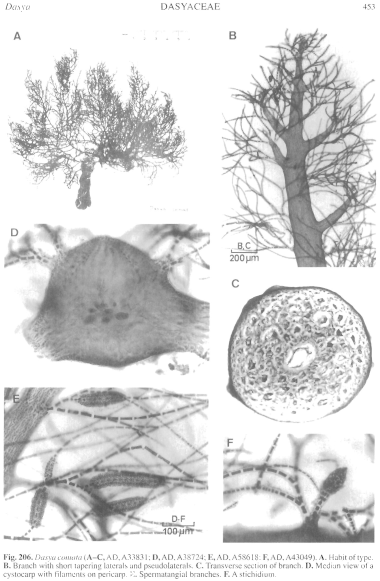|
|
|
|
|
|||||||||||
|
Electronic Flora of South Australia Species Fact Sheet
Phylum Rhodophyta – Order Ceramiales – Family Dasyaceae
Thallus (Fig. 206A) dark brown-red, mucilaginous, 5–15 cm high, spreading, usually with several axes. Main axes (Fig. 206B) bearing longer branches radially, sometimes subdistichously, with short interspersed branches, heavily corticated to very close to branch tips, 1–1.5 mm in diameter. Ultimate branches tapering abruptly, bearing at the tips spirally arranged, subdichotomous, monosiphonous pseudolaterals which often have corticated basal cells. Lateral axes apparently arise from the basal cells of pseudolaterals. Holdfast discoid, 1–3 mm in diameter; on solid substrates. Structure. Pericentral cells 5, cut off very close to apices and rapidly corticated, with the pericentral cells becoming separated from the axial filament by rhizoids and relatively obscure (Fig. 206C), outer cortical cells isodiametric to slightly elongate, irregularly placed. Pseudolaterals one per segment, lost shortly below the apices, 0.5–1.5 mm long, basally branched 3–5 times 2 or 3 cells apart, with adherent lower walls at subdichotomies, with long unbranched ends; lower cells 20–25 µm in diameter and L/D (1–) 1.5–2.5, tapering gradually to upper cells 7–10 µm in diameter and L/D 3–5 (–8). Occasional adventitious filaments occur, similar to pseudolaterals. Rhodoplasts discoid.
Reproduction: Gametophytes dioecious. Procarps not observed. Carposporophyte much branched, with terminal rows of ovoid carposporangia 15–20 µm in diameter. Cystocarps (Fig. 206D) sessile on short laterals, globular, 600–800 µm across; pericarp 3–5 cells thick, outer cells more or less isodiametric and 6–8 µm across and bearing adventitious branched filaments corticated basally. Spermatangial branches (Fig. 206E) as lower parts of ultimate branches of pseudolaterals, with long sterile terminal ends, 100–300 µm long and 40–55 µm in diameter.
Tetrasporangial stichidia (Fig. 206F) (few seen) on lower branches of pseudolaterals, 100–180 µm long and 45–70 µm in diameter, short lanceoid, with a monosiphonous pedicel, each whorl with probably 5 sporangia 20–25 µm in diameter.
Type from off Troubridge I., S. Aust., 23 m deep (Shepherd, 4.ii.1969); holotype in AD, A33831. Isotypes in AD, CHR, 315579.
Distribution: Waldegrave I., S. Aust. to Gabo I., Vic.
Taxonomic notes: D. comata is a name used by J. Agardh on specimens from Westernport, in LD and MEL, doubtless referring to the terminal tufts of pseudolaterals, but never published. The species is distinct in habit, with cortication commencing and becoming heavy very close to the apices.
References: The Marine Benthic Flora of Southern Australia Part IIIC
Publication:
Womersley, H.B.S. (24 December, 1998)
The Marine Benthic Flora of Southern Australia
Rhodophyta. Part IIIC. Ceramiales – Ceramiaceae, Dasyaceae
©State Herbarium of South Australia, Government of South Australia
Illustration in Womersley Part IIIA, 1998: FIG. 206.

Figure 206 enlarge
Fig. 206. Dasya comata (A–C, AD, A33831; D, AD, A38724; E, AD, A58618; F, AD, A43049). A. Habit of type. B. Branch with short tapering laterals and pseudolaterals. C. Transverse section of branch. D. Median view of a cystocarp with filaments on pericarp. E. Spermatangial branches. F. A stichidium.

|
Email Contact: State Herbarium of South Australia |

|